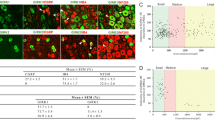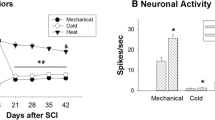Abstract
Traumatic spinal cord injury (SCI) results not only in motor impairment, but also in chronic central neuropathic pain, which often is refractory to conventional treatment approaches. Upregulated expression of sodium channel Nav1.3 has been observed within the spinal dorsal horn neurons after SCI, and appears to contribute to neuronal hyperresponsiveness and pain-related behaviors. In this study we characterized the changes in sodium current properties within dorsal horn neurons after contusive SCI. Four weeks after adult male Sprague-Dawley rats underwent T9 spinal cord contusion injury, when behavioral nociceptive thresholds were decreased to both mechanical and thermal stimuli, whole-cell patch-clamp recordings were performed on acutely dissociated lumbar dorsal horn neurons. The cells demonstrated characteristic fast-activating and fast-inactivating sodium currents. SCI led to a shift of the steady-state activation and inactivation of the sodium current towards more depolarized potentials. The shifted steady-state inactivation shows similarities to that obtained from axotomized dorsal root ganglions, which were shown to upregulate Nav1.3. Small slow depolarizations below action potential threshold produced ramp currents, which were markedly enhanced by SCI (from 182 ± 41 to 338 ± 55 pA). The density of the noninactivating persistent sodium current was also significantly enhanced in neurons from SCI animals (from 17.4 ± 3.2 to 27.7 ± 4.4 pA/pF at 50–70 ms of depolarization). The increased persistent sodium current and ramp current, which are consistent with upregulation of Nav1.3 within dorsal horn neurons, suggest a basis for the hyperresponsiveness of these neurons following SCI.



Similar content being viewed by others
Abbreviations
- SCI:
-
Spinal cord injury
- DRG:
-
Dorsal root ganglia
References
Azouz R, Jensen MS, Yaari Y (1996) Ionic basis of spike after-depolarization and burst generation in adult rat hippocampal CA1 pyramidal cells. J Physiol 492(Pt 1):211–223
Beckh S, Noda M, Lubbert H, Numa S (1989) Differential regulation of three sodium channel messenger RNAs in the rat central nervous system during development. EMBO 8:3611–3616
Black JA, Cummins TR, Plumpton C, Chen YH, Hormuzdiar W, Clare JJ, Waxman SG (1999) Upregulation of a silent sodium channel after peripheral, but not central, nerve injury in DRG neurons. J Neurophysiol 82:2776–2785
Brysch W, Creutzfeldt OD, Luno K, Schlingensiepen R, Schlingensiepen KH (1991) Regional and temporal expression of sodium channel messenger RNAs in the rat brain during development. Exp Brain Res 86:562–567
Christensen MD, Hulsebosch CE (1997) Chronic central pain after spinal cord injury. J Neurotrauma 14:517–537
Cummins TR, Waxman SG (1997) Downregulation of tetrodotoxin-resistant sodium currents and upregulation of a rapidly repriming tetrodotoxin-sensitive sodium current in small spinal sensory neurons after nerve injury. J Neurosci 17:3503–3514
Cummins TR, Aglieco F, Renganathan M, Herzog RI, Dib-Hajj SD, Waxman SG (2001) Nav1.3 sodium channels: rapid repriming and slow closed-state inactivation display quantitative differences after expression in a mammalian cell line and in spinal sensory neurons. J Neurosci 21:5952–5961
Drew GM, Siddall PJ, Duggan AW (2004) Mechanical allodynia following contusion injury of the rat spinal cord is associated with loss of GABAergic inhibition in the dorsal horn. Pain 109:379–388
Felts PA, Yokoyama S, Dib-Hajj S, Black JA, Waxman SG (1997) Sodium channel alpha-subunit mRNAs I, II, III, NaG, Na6 and hNE (PN1): different expression patterns in developing rat nervous system. Brain Res Mol Brain Res 45:71–82
Franceschetti S, Guatteo E, Panzica F, Sancini G, Wanke E, Avanzini G (1995) Ionic mechanisms underlying burst firing in pyramidal neurons: intracellular study in rat sensorimotor cortex. Brain Res 696:127–139
Furuyama T, Morita Y, Inagaki S, Takagi H (1993) Distribution of I, II and III subtypes of voltage-sensitive Na+ channel mRNA in the rat brain. Brain Res Mol Brain Res 17:169–173
Gruner JA (1992) A monitored contusion model of spinal cord injury in the rat. J Neurotrauma 9:123–126; discussion 126–128
Hains BC, Willis WD, Hulsebosch CE (2002) Differential electrophysiological effects of brain-derived neurotrophic factor on dorsal horn neurons following chronic spinal cord hemisection injury in the rat. Neurosci Lett 320:125–128
Hains BC, Johnson KM, Eaton MJ, Willis WD, Hulsebosch CE (2003a) Serotonergic neural precursor cell grafts attenuate bilateral hyperexcitability of dorsal horn neurons after spinal hemisection in rat. Neuroscience 116:1097–1110
Hains BC, Klein JP, Saab CY, Craner MJ, Black JA, Waxman SG (2003b) Upregulation of sodium channel Nav1.3 and functional involvement in neuronal hyperexcitability associated with central neuropathic pain after spinal cord injury. J Neurosci 23:8881–8892
Hains BC, Willis WD, Hulsebosch CE (2003c) Temporal plasticity of dorsal horn somatosensory neurons after acute and chronic spinal cord hemisection in rat. Brain Res 970:238–241
Hamill OP, Marty A, Neher E, Sakmann B, Sigworth FJ (1981) Improved patch-clamp techniques for high-resolution current recording from cells and cell-free membrane patches. Pflugers Arch 391:85–100
Kay AR, Wong RK (1986) Isolation of neurons suitable for patch-clamping from adult mammalian central nervous systems. J Neurosci Methods 16:227–238
Loeser JD, Ward AA Jr, White LE Jr (1968) Chronic deafferentation of human spinal cord neurons. J Neurosurg 29:48–50
Pennartz CM, Bierlaagh MA, Geurtsen AM (1997) Cellular mechanisms underlying spontaneous firing in rat suprachiasmatic nucleus: involvement of a slowly inactivating component of sodium current. J Neurophysiol 78:1811–1825
Prescott SA, De Koninck Y (2005) Integration time in a subset of spinal lamina I neurons is lengthened by sodium and calcium currents acting synergistically to prolong subthreshold depolarization. J Neurosci 25:4743–4754
Safronov BV, Wolff M, Vogel W (1997) Functional distribution of three types of Na+ channel on soma and processes of dorsal horn neurones of rat spinal cord. J Physiol 503(Pt 2):371–385
Safronov BV, Wolff M, Vogel W (1999) Axonal expression of sodium channels in rat spinal neurones during postnatal development. J Physiol 514(Pt 3):729–734
Taddese A, Bean BP (2002) Subthreshold sodium current from rapidly inactivating sodium channels drives spontaneous firing of tuberomammillary neurons. Neuron 33:587–600
Vreugdenhil M, Hoogland G, van Veelen CWM, Wadman WJ (2004) Persistent sodium current in subicular neurons isolated from patients with temporal lobe epilepsy. Eur J Neurosci 19:2769–2778
Waxman SG (2000) The neuron as a dynamic electrogenic machine: modulation of sodium-channel expression as a basis for functional plasticity in neurons. Philos Trans R Soc Lond B Biol Sci 355:199–213
Waxman SG, Hains BC (2006) Fire and phantoms after spinal cord injury: Na(+) channels and central pain. Trends Neurosci 29(4):207–215
Waxman SG, Kocsis JD, Black JA (1994) Type III sodium channel mRNA is expressed in embryonic but not adult spinal sensory neurons, and is reexpressed following axotomy. J Neurophysiol 72:466–470
Wiesenfeld-Hallin Z, Aldskogius H, Grant G, Hao JX, Hokfelt T, Xu XJ (1997) Central inhibitory dysfunctions: mechanisms and clinical implications. Behav Brain Sci 20:420–425; Discussion 435–513
Acknowledgments
The authors thank Boris V. Safronov and Sónia F. A. Santos for their advice on surgery and slice preparation and Bart Toftness for technical assistance. This work was supported in part by grants from the Medical Research Service and Rehabilitation Research Service, Department of Veterans Affairs and the National Multiple Sclerosis Society. The Center for Neuroscience and Regeneration Research is a Collaboration of the Paralyzed Veterans of America and the United Spinal Association. AL was funded by the Epilepsy Foundation of America (Postdoctoral Research Training Fellowship). BCH was funded by The Christopher Reeve Paralysis Foundation (HB1-0304-2), the NIH/NINDS (1 F32 NS046919-01), and Pfizer (Scholar’s Grant in Pain Medicine).
Author information
Authors and Affiliations
Corresponding author
Rights and permissions
About this article
Cite this article
Lampert, A., Hains, B.C. & Waxman, S.G. Upregulation of persistent and ramp sodium current in dorsal horn neurons after spinal cord injury. Exp Brain Res 174, 660–666 (2006). https://doi.org/10.1007/s00221-006-0511-x
Received:
Accepted:
Published:
Issue Date:
DOI: https://doi.org/10.1007/s00221-006-0511-x




